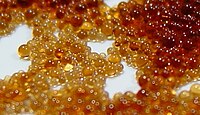
Photo from wikipedia
In this study, two different types of ion exchange membranes are used to investigate the tendency of membrane fouling with respect to surface roughness and hydrophilicity. Commercially available membranes reinforced… Click to show full abstract
In this study, two different types of ion exchange membranes are used to investigate the tendency of membrane fouling with respect to surface roughness and hydrophilicity. Commercially available membranes reinforced by electrospun nanofiber have rough and hydrophilic surfaces, and lab-made pore-filling membranes exhibit a smooth and hydrophobic surface. Three different organic surfactants (i.e., cationic, anionic and non-ionic surfactants) are chosen as foulants with similar molecular weights. It is confirmed that membrane fouling by electrical attraction mainly occurs, in which anionic and cationic foulants influence anion and cation exchange membranes, respectively. Thus, less fouling is obtained on both membranes for the non-charged foulant. The membranes with a rough surface show a higher fouling tendency than those with a smooth surface in the short-term continuous fouling tests. However, during the cyclic operations of fouling and mitigation of the commercially available membranes, the irregularities of a rough membrane surface cause a rapid increase in electrical resistance from the beginning of fouling due to excessive adsorption on the surface, but the fouling is easily mitigated due to the hydrophilic surface. On the other hand, the membranes with a smooth surface show alleviated fouling from the beginning of fouling, but the irreversible fouling occurs as foulants accumulate on the hydrophobic surface which causes membrane fouling to be favorable.
Journal Title: Membranes
Year Published: 2023
Link to full text (if available)
Share on Social Media: Sign Up to like & get
recommendations!